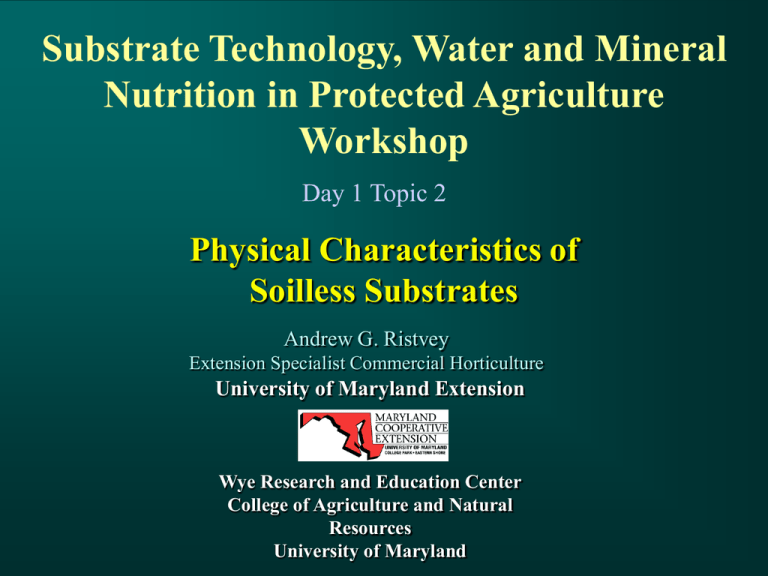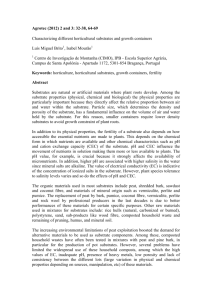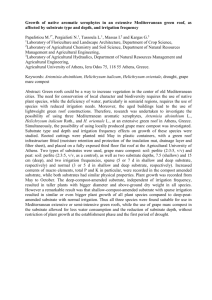Composting and Aging - College of Agriculture & Natural Resources
advertisement

Substrate Technology, Water and Mineral Nutrition in Protected Agriculture Workshop Day 1 Topic 2 Physical Characteristics of Soilless Substrates Andrew G. Ristvey Extension Specialist Commercial Horticulture University of Maryland Extension Wye Research and Education Center College of Agriculture and Natural Resources University of Maryland Smarter Substrate Management Objectives for this topic include: Review soilless substrate physical properties Relate those factors to air and water availability Evaluations for physical properties Soils vs Soilless Substrates What are the important physical differences between soils and soilless substrates? Parent materials or components Porosity Particle size Air and water availability Particle Size Soils Soilless Substrates Composition Particle Size = Pore Perlite Pinebark USDA System Texture Structure ACE / NETC 99 Soilless Substrates Physical Properties Three Phases of Growing Media by volume Solid (matrix) – 33 to 50% Liquid (water) – 15 to 45% 45% Solid Gas (air) – 10 to 40% (matrix) Water % + Air % = Total Pore Space Matrix Component Porosity: determines the ratio between Water % 10 - 40% Air Air % Total Pore Space 15 - 45% Water Variability of Components • Highly Variable – Physical properties • Very porous • Leach very easily • Various combinations • Plant Available Water – the % volume of water that plants can retrieve • Peat Moss Perlite • Pinebark Pine bark • Perlite • Coir • Rice Hulls • Shredded palm leaves and other organics • Sand • Gravel • Vermiculite Component Structure Electron micrograph of Sphagnum Peat (Handreck & Black, 1994) Typical Substrates Utilized in Costa Rica Porosity: Air and Water Availability Physical Properties Particle Size and Composition: Their affect on: Air-Filled Porosity (AFP) Water Holding Capacity (WHC) AFP - air in the substrate after irrigation / drainage WHC – water in the substrate after irrigation / drainage Pores When we buy substrate---we are buying pores! What else can affect substrate AFP and WHC? Handling Watering Age Container geometry Potting - do not compress substrate - water the plant in Components Affect AFP and WHC Porosity: water Macropores Water drain through freely (< 4mm) Mesopores Water at CC (1 to 0.5mm) Micropores Water might work as “buffer” (0.5 to 0.03mm) Ultramicropores Water held beyond 1.5 Mpa (<0.01mm) Drzal et al. (1999) air water air Soil particles Soil particles Components Affect AFP and WHC • Particle size affects WHC and AFP • Capillary action - water tension - water is attracted to surfaces with a force large enough to support a relatively large mass of water against the ‘pull' of gravity - the smaller the particle, the more firm the hold Components Affect AFP and WHC Physical Properties : Pore Size • Pore size affects WHC and AFP Soilless Substrates Important Attributes of Soilless Media Recommended physical characteristic values for soilless substrates, after irrigation and drainage are (% volume): • Air-Filled Porosity - 10 to 30% or 20 to 35% (field test) • Water Holding Capacity - 45 to 65%; • Available water content - 25 to 35%; • Unavailable water content - 25 to 35%; Note: A substrate with many coarse particles has a large air space and a relatively low water holding capacity. Field Test for AFP W1 = Saturated container media W2 = Drained container (several hours later) W3 = Volume of Substrate W4 = Weight of Container W5 = Weight of Dry Media % AFP = WHC = % W1 – W2 Saturation AFP X 100 W3 – W4 W2 – (W5 + W4) W3 X 100 Total Volume Substrate Technology, Water and Mineral Nutrition in Protected Agriculture Workshop Day 1 Topic 3 Substrate Management Andrew G. Ristvey Extension Specialist Commercial Horticulture University of Maryland Extension Wye Research and Education Center College of Agriculture and Natural Resources University of Maryland Smarter Substrate Management Objectives for this topic include: Composting and aging Storage of substrates Handling of substrates Composting and Aging Composting is a biological process where complex organic material is degraded into more basic organic components at a rate faster than decomposition would occur naturally. Aerobic Composting is a thermophilic (generating heat) process Aging is not composting, because there is no heat generation Composting and Aging The process of efficient composting requires several ingredients. The basic recipe: 1. A source of organic material 2. Microorganisms 3. C:N ratio of more than 30:1 – this may mean the addition of a nitrogen or carbon source 4. Proper moisture levels – 45 to 60% by weight 5. Oxygen 6. pH stabilizer, if needed Composting and Aging Composting Chemistry: The C:N Ratio Materials High in Carbon C/N* Senesced leaves 30-80:1 straw 40-100:1 wood chips or sawdust 100-500:1 bark 100-130:1 mixed paper 150-200:1 newspaper or corrugated cardboard 560:1 Materials High in Nitrogen C:N* vegetable scraps 15-20:1 coffee grounds 20:1 grass clippings 15-25:1 manure 5-25:1 Composting and Aging The result of efficient aerobic composting is . 1. Generation of Heat ≈ 55 Co 2. C:N Ratio of between 10 and 15 : 1 3. Degradation of organic material and increase Cation Exchange Capacity Composting and Aging Microorganisms Composting and Aging The Aerobic Cycle http://www.theteggroup.plc.uk/technical_library/microbiology_of_invessel_composting Composting and Aging Cellulose and Lignin… Why some substrates degrade faster than others 1. Cellulose is a sugar 2. Lignin is a more complicated molecule and more difficult to degrade Cellulose Lignin Composting and Aging When it goes wrong… 1. Compounds like alcohols and methane are developed in anaerobic composting. 2. Weed and pathogens are not destroyed Adding Compost to Growing Media • • • • Consistency – can you assure? Well/properly composted Water Holding capacity Pore Space? Nutrient availability – what is in compost? – adjust your nutrient management plan? Adding Compost to Growing Media • First, analyze your compost – All macro and micro nutrients • How much should be added? – Base your addition on nutrients, WHC AFP and EC – Usually no more than 20% • Check your WHC and AFP Smarter Substrate Management There are three lines of defense against plant diseases To prevent pathogens from entering the production systems Create cultural conditions that work for plant growth and against disease development Correctly and timely treat disease problems that do arise But first… Prevention! is crucial to successful plant health management Storage of Substrates Storage of Substrates Storage – high and dry? Potting - do not compress substrate - water the plant into pot What else? Handling Watering Age Storage of Substrates Practical Examination for Substrates Capillary Force practical experiment Particle Distribution Analysis Field Porosity and water holding capacity tests Question: Does particle size affect AFP and WHC? Substrate Re-use and handling Substrate Technology, Water and Mineral Nutrition in Protected Agriculture Workshop Day 2 Topic 4 Irrigation in Protected Environments: Checking Irrigation System Efficiency John Lea-Cox and David Ross Nursery Extension Specialist / Extension Engineer University of Maryland Extension College of Agriculture and Natural Resources University of Maryland Overhead Irrigation Systems The pros and cons of overhead irrigation systems. Cons Pros 1. Easy management 1. Efficiency low - depending 2. Lower labor costs 2. Larger volumes needed 3. Less infrastructure 3. Higher pressures needed Micro Irrigation Systems The pros and cons of microirrigation systems. Pros Cons 1. Higher Efficiency 1. Greater management 2. Less volume needed 3. Lower pressures 2. Higher costs – more specialized equipment needed 4. Less waste 3. Potential Higher labor costs Irrigation Audits Summary Is your irrigation system working properly? First, do an inspection & repair problems. Second, check pressures and flow rates. Third, do a test for uniform application. Decide on changes to improve system and water wisely. ACE / NETC 99 Uniform Water Application? Applying water uniformly should be goal # 1, particularly for container crops Question - Where are your dry spots after irrigation? If none, do you knowingly overwater some plants to adequately water other plants? How do I check my irrigation system? ACE / NETC 99 System Audit Procedure First, inspect for problems and repair them. 1. Damaged pipelines and risers 2. Damaged, clogged, worn, or broken nozzles or drip tubes. ACE / NETC 99 System Audit Procedure Second, check pressure and flow rate. 1. What were the pressures and flow rates of the system when new? 2. Check pressure at pump, beginning and end of laterals, and before and after filters. 3. Check the nozzles for wear and flow rate. Check drip tubes for clogging. ACE / NETC 99 Pressure Check Installed or Portable Pressure Gauges Pressure Check Filter Laterals – drip or sprinkler Pump Pressure Gauge Pressure variation in a Lateral For good design, pressure variation from one end of a lateral to the other should not exceed +/- 10 percent of the average lateral design pressure. Actual variation in lateral is 20%. 55 psi Average of 50 psi 45 psi Pressure affects Application Pattern Nozzle Pressure versus Water Distribution Pattern Too High Correct Pressure Too Low Correct operating pressure is best! Pressure too high or too low causes distortion of application pattern. Nozzle Flow Rate Use a bottle or bucket to catch the water discharged from the nozzle for one minute. Measure the volume of water caught. Convert to gal/min. as in nozzle chart. Measure nozzle pressure, if possible. Nozzle Flow Rate RainBird 14DH Nozzle (new) specs for water discharge at a given pressure. Nozzle Flow Rate RainBird 14DH Note changes in gpm for changes in PSI. Nozzle Wear Check Use drill bit to check size carefully. Nozzle Wear RainBird 14DH Note changes in gpm & radius for changes in Size. Wear changes demand on the pump. Nozzle Pressure & Flow Rate Let’s review the last few slides – We checked nozzle wear, pressure and flow rate. From the nozzle chart we saw that a different pressure resulted in a different discharge and wetted radius. Differences mean non-uniformity! Application Uniformity Check The next step is to check on the application uniformity of your system. This process uses a grid pattern of water catch cans to collect water. A regular pattern of cans is placed on the ground in the irrigated area. Application Uniformity Check Catch can – top left Calibrated measuring container – bottom left/ top right Application Uniformity Check Audit Kit Irrigation Association Education Foundation www.iaef.org Application Uniformity Check Catch cans - use 16 or more. Do audit to sample application uniformity several places. Application Uniformity Check Catch cans Irrigation Lateral Production Bed – Hoop House Must run all laterals that cover catch area. Lower Quarter Distribution Uniformity, DULQ List in descending order. Mark smallest quarter. Average of total and smallest 1/4 . Sketch of laterals and sprinklers. Show catch cans and amounts of water. [Divide Average of ¼ by Average of total] x 100 Readings: (use 16, 20, 24 or more) 0.32 0.34 0.32 0.34 0.30 0.28 0.25 0.30 0.33 0.30 0.27 0.33 0.36 0.24 0.31 0.37 Total of all = 4.96 Average All= 0.31 Total small 1/4 = 1.04; Average 1/4 = 0.26 DULQ = [0.26 / 0.31] x 100 = 84 % Doing the Math – easy! We calculate the “Lower Quarter Distribution Uniformity, DULQ” DULQ = [Avg of smaller 1/4 readings / Avg of all readings] x 100 Tells us how close the lowest (dry) readings are to all readings. Less than 70-75 percent is not so good. Summary Correct pressure and nozzle/emitter flow rates are important factors in overall uniformity of a system. The Lower Quarter Uniformity Distribution gives us a measure of the uniformity of application. Check out your system soon! Substrate Technology, Water and Mineral Nutrition in Protected Agriculture Workshop Day 2 Topic 5 Irrigation in Protected Environments Plant/Substrate Relations Andrew G. Ristvey Extension Specialist Commercial Horticulture University of Maryland Extension Wye Research and Education Center College of Agriculture and Natural Resources University of Maryland Smarter Irrigation Management Manage irrigation and substrate water content Are we over-watering? Water logging will increase the incidence of disease Water-use efficiency research at UGA showed that during a 6 week trial, Vinca (Catharanthus roseus) could be grown with liter of water without reduction in mass or quality Why don’t we use soil in containers? Key reason – too many fine particles, which leads to waterlogging Also, bottom of container creates a barrier to drainage resulting in a “perched” water table The smaller the particle size, the higher the perched table Soilless substrates degrade in time and act like soils Container Size and Water Holding Capacity Given the same substrate Given the same volume Moisture/air gradient – capillary action Squat containers hold more water AFP and WHC based on Container Size 100 90 80 70 % Water 60 50 40 % Solid 30 20 10 % Air 0 6 inch 4 inch 48 cell 512 cell Adapted from A Grower’s Guide to Water, Media, & Nutrition for Greenhouse Crops, Ed. David Wm. Reed, 1996. Plant Available Water Soils and substrates have the ability to hold and release water Some water is available for the plants Some water is not available for the plants …even though the substrate or soil may seem moist Why? Recall our lesson about particle size and water attraction Plant Available Water Electron micrograph of Sphagnum Peat Plant Available Water Soils and substrates have the ability to hold and release water Some water is available for the plants Some water is not available for the plants Even though the substrate or soil may seem moist Why? Recall our lesson about particle size water attraction Plant Available Water is the water that held by the soil or substrate Divided into: Easily Available Water and Water Buffer Capacity Plant Available Water (Handreck & Black, 1994) 100 Water Volume % (20 cm high pot) Unavailable Total Pore Water (progressively) Easily Available Space Buffer capacity Air Readily available water Air Air Filled Porosity (at container capacity) Solids 0 0 -1 (Handreck & Black, 1994) set points -5 Suction applied (kPa) 7 kPa = 1 PSI -10 Finding Plant Available Water Desorption curves generated using a custom-built desorption table using 5 and 20cm long Ech2O capacitance sensors. Ten columns were simultaneously desorbed for each substrate (n=30). Finding Plant Available Water Each column was packed by slowly adding and settling the substrate with water Each column had a capacitance probe sealed into the top polycarbonate lid, positioned centrally and vertically down the column Once sealed, each column was slowly hydrated over 6 hours to gradually force the interstitial air out of the substrate Finding Plant Available Water Positive gas pressure was incrementally applied at 1, 2, 4, 6, 8, 10, 20, 40, 60, 80 and 100 kPa The volume of water expressed at each pressure increment was measured for each column Results – Physical Properties (5cm columns) 100% Perlite 80 Pine Bark : 20 Peat Pressure (kPa) † 100% Coir 100% Pine Bark 80 Peat: 20 Perlite Distribution of Water (%) EAW (1 to 5) 36.0 40.0 32.6 34.6 43.7 WBC (5 to 10) 1.2 7.0 2.1 2.2 13.1 PUW ( >10 ) 62.8 53.0 65.3 63.2 34.1* Total volume of the 5-cm column = 722 mL. Note that CC = TP - AS. Use CC values to interconvert data. * An additional 9.1 % water was expressed from this substrate between 10 and 60 kPa (to total 100%) Determination of Leaching Fraction Substrate Technology, Water and Mineral Nutrition in Protected Agriculture Workshop Day 3 Topic 9 Knowledge Center - Access to Online Resources Andrew G. Ristvey Extension Specialist Commercial Horticulture University of Maryland Extension Wye Research and Education Center College of Agriculture and Natural Resources University of Maryland




